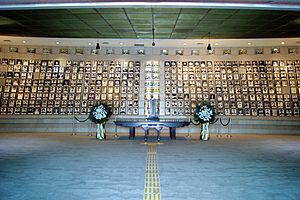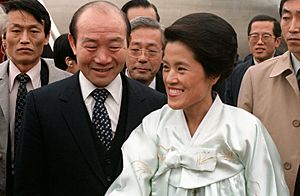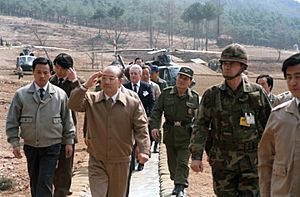Chun Doo-hwan facts for kids
Quick facts for kids
Chun Doo-hwan
|
|
|---|---|
|
전두환
全斗煥 |
|
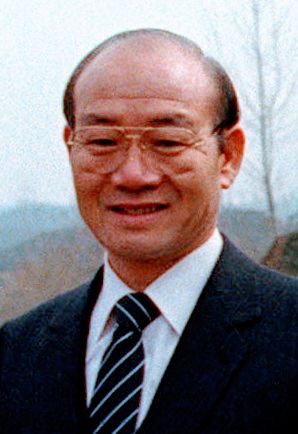
Chun in 1983
|
|
| 5th President of South Korea | |
| In office 1 September 1980 – 24 February 1988 |
|
| Prime Minister | Yoo Chang-soon Kim Sang-hyup Chin Iee-chong Lho Shin-yong Lee Han-key Kim Chung-yul |
| Preceded by | Choi Kyu-hah Pak Choong-hoon (acting) |
| Succeeded by | Roh Tae-woo |
| President of the Democratic Justice Party | |
| In office 15 January 1981 – 10 July 1987 |
|
| Preceded by | Position established |
| Succeeded by | Roh Tae-woo |
| Personal details | |
| Born | 18 January 1931 Hapcheon, Japanese Korea (now Hapcheon County, South Gyeongsang Province, South Korea) |
| Died | 23 November 2021 (aged 90) Yeonhui-dong, Seoul, South Korea |
| Political party | Democratic Justice |
| Spouse |
Lee Soon-ja
(m. 1958) |
| Children | 4 |
| Alma mater | Korea Military Academy (B.S.) |
| Religion | Korean Buddhism prev. Roman Catholic |
| Signature |  |
| Military service | |
| Allegiance | South Korea |
| Branch/service | Republic of Korea Army |
| Years of service | 1951–1988 |
| Rank | General |
| Commands | Defense Security Command, KCIA |
| Battles/wars | Vietnam War |
| Korean name | |
| Hangul |
전두환
|
| Hanja |
全斗煥
|
| Revised Romanization | Jeon Duhwan |
| McCune–Reischauer | Chŏn Tuhwan |
| Art name | |
| Hangul |
일해
|
| Hanja |
日海
|
| Revised Romanization | Ilhae |
| McCune–Reischauer | Irhae |
| Courtesy name | |
| Hangul |
용성
|
| Hanja |
勇星
|
| Revised Romanization | Yongseong |
| McCune–Reischauer | Yongsŏng |
Chun Doo-hwan (Korean: 전두환; Hanja: 全斗煥; born 18 January 1931 – died 23 November 2021) was a South Korean army general. He became a powerful leader in South Korea from 1979 to 1980. He then served as the president of South Korea from 1980 to 1988.
Chun took control after President Park Chung-hee was assassinated in 1979. Park had been a military leader since 1962. Chun led a military takeover on 12 December 1979. He then made his power stronger with another military action on 17 May 1980. During this time, he declared martial law, which meant the military took over the government. He also set up a special camp for "purificatory education." On 3 March 1981, he created the Fifth Republic of Korea, which was a very strict government.
In 1987, many people protested for democracy in what was called the June Struggle. Chun then agreed to allow a presidential election in December 1987. His close friend, Roh Tae-woo, won this election. Roh continued many of Chun's policies into the 1990s.
In 1996, Chun was found responsible for his role in stopping the Gwangju Uprising. This event led to the deaths of many citizens. He was later pardoned (forgiven) in 1997 by President Kim Young-sam. This decision was made with advice from the new President-elect, Kim Dae-jung. Chun and Roh Tae-woo were also ordered to pay large fines. These fines were for money they had taken through corruption during their time in power. Most of this money was never paid back.
In his later years, Chun was criticized for not saying sorry for his actions as a leader. He died on 23 November 2021, at the age of 90, due to a type of blood cancer.
Contents
Early Life and Education
Chun was born on 18 January 1931, in a poor farming town called Yul-Gok myeon. This town is in Hapcheon County, South Gyeongsang Province, which was then part of Japanese Korea. Chun was the fourth of ten children.
Around 1936, his family moved to Daegu. He started elementary school there. Later, his family moved to Jilin, in a region called Manchukuo. Chun went back to elementary school there, but he was two years behind his age group.
In 1947, Chun began attending Daegu Vocational Middle School. This school was about 25 kilometers from his home. He then went on to Daegu Vocational High School.
Military Career
After finishing high school in 1951, Chun joined the Korea Military Academy (KMA). Here, he made important friends who would later help him gain power. He graduated in February 1955. He earned a Bachelor of Science degree and became a second lieutenant.
He later trained in the United States. He learned about guerilla tactics and psychological warfare. In 1958, he married Lee Soon-ja. Her father was the KMA's leader when Chun was a student.
In 1961, Chun, who was then a captain, supported the May 16 coup. This was a military takeover led by Park Chung Hee. Chun then became a secretary to a high-ranking official under Park. He was quickly promoted to major in 1962. He continued to make powerful friends. As a major, he worked in the Republic of Korea Army Special Warfare Command. He also worked for the Supreme Council for Reconstruction. In 1963, Chun got a job in the Korean Central Intelligence Agency (KCIA). By 1969, he was a senior advisor to the Army Chief of Staff.
In 1970, Chun was a colonel. He led the 29th Regiment of the South Korean 9th Infantry Division. He also fought in the Vietnam War. When he returned to Korea in 1971, he led the 1st Special Forces Brigade. He was later promoted to brigadier general. In 1976, he worked for the Presidential Security Service. He became a major general during this time. In 1978, he became the commanding officer of the 1st Infantry Division.
Finally, in 1979, he was put in charge of the Defense Security Command. This was his highest position yet.
Rise to Power
Hanahoe Military Club
Chun created a secret military club called Hanahoe. He started it soon after he became a general. Most members were his friends who graduated from the Korea Military Academy. The club was mainly for officers from the Gyeongsang Province. This secret group could exist because President Park Chung Hee supported it.
After Park Chung-hee's Assassination
On 26 October 1979, South Korean President Park Chung Hee was assassinated. This happened during a dinner party. The assassin was Kim Jae-kyu, who led the KCIA. After this event, Prime Minister Choi Kyu-ha became the Acting President.
Soon after, Chun's Security Command was chosen to investigate the assassination. Chun quickly set up a powerful "Joint Investigation Headquarters." On 27 October, Chun met with leaders of all intelligence groups. He told them the KCIA was responsible for the assassination. He then took control of all intelligence reports. This meant Chun now controlled all of the nation's intelligence organizations.
A major working under Chun, Park Jun-kwang, said he was surprised how easily Chun took control. Chun also gave money from President Park's secret fund to Park's daughter, Park Geun-hye. General Jeong, a higher-ranking officer, criticized Chun for this.
The 12 December Coup
In the month after the assassination, Chun and his friends from the Hanahoe club grew stronger. They used the unstable political situation to gain more power.
On 12 December 1979, Chun ordered the arrest of Army Chief of Staff Jeong Seung-hwa. Chun accused Jeong of working with the assassin. This order was given without President Choi's approval. That night, Chun's loyal troops moved into Seoul. They took control of the Ministry of Defense and Army Headquarters. By the next morning, Chun was in firm control of the military. He was now the real leader of the country.
In early 1980, Chun was promoted to lieutenant general. He also became the acting director of the KCIA. On 14 April, he was officially made the director of the KCIA.
Martial Law and Gwangju Movement
On 17 May 1980, Chun expanded martial law across the whole country. He said it was because of rumors of North Korean spies. However, some believed this was an excuse for Chun to gain more power.
Under martial law, universities were closed, political activities were banned, and the press was controlled. This marked the start of another military rule. Many citizens were unhappy with the military presence. On 18 May, people in Gwangju started protesting. This became known as the Gwangju Democratization Movement.
Chun ordered the protests to be stopped immediately. He sent in military troops with tanks and helicopters. The troops were told to use full force. This led to many deaths over the next two days. The Gwangju Democratization Movement ended, and hundreds of citizens died.
Becoming President
In June 1980, Chun ordered the National Assembly (the country's parliament) to be closed. He then created a new group called the Special Committee for National Security Measures (SCNSM). This group was like a military government, and Chun became a member. On 17 July, he left his job as KCIA Director.
On 5 August, with full control of the military, he promoted himself to four star General. On 22 August, he left active duty in the Army.
Samchung Re-education Camp
Starting in August 1980, many citizens were arrested without proper reasons. This was part of a "social cleansing" effort. About 42,000 people were sent to the Samchung re-education camp. They were told it was for "purificatory education." More than 60,000 people were arrested in six months. Many innocent people were among them. They faced difficult conditions in the camp.
As President (1980–1987)
Policies and Changes
In August 1980, Choi Kyu-hah, who was president but had little power, resigned. On 27 August, a group called the National Conference for Unification voted for a new president. Chun was the only candidate. Almost all members voted for Chun. He officially became president on 1 September 1980.
On 17 October, he ended all political parties. In November, he changed how the press worked. In January 1981, Chun started his own party, the Democratic Justice Party. Soon after, a new constitution was put in place. This new constitution was less strict than the previous one. For example, it protected the privacy of letters and banned torture.
Chun was re-elected president in February 1981. He won with 90 percent of the votes from delegates. His party also won many seats in the National Conference.
Missile Agreement
In 1980, Chun made an agreement with the United States. He promised that South Korea would not build missiles that could fly farther than 180 kilometers. They also agreed the missiles would not carry warheads heavier than 453 kilograms. After this promise, the U.S. government recognized Chun's leadership.
Later, in the late 1990s, South Korea and the U.S. changed this agreement. South Korea was allowed to have missiles that could fly up to 300 kilometers. These missiles could carry warheads up to 500 kilograms. This new agreement started in 2001.
Changes from Park Chung-hee's Era
After becoming president in 1981, Chun tried to distance himself from Park Chung-hee's time in office. He even removed mentions of Park's 1961 military takeover from the constitution. Chun said he would bring fairness back to the government.
Nuclear Program Ended
Chun's government did not have as much political power as Park Chung-hee's. Chun could not ignore the influence of the United States. So, he ended South Korea's nuclear weapons program. Chun wanted to improve relations with the U.S., which had become difficult under Park. He needed the U.S. to accept his government.
Other Reforms
After he became president, Chun made some changes. He stopped private tutoring outside of school. In September 1980, he ended "guilt by association" laws. In 1981, he made a law about keeping criminals in custody after their prison time.
In the winter of 1984, Chun visited Japan and asked for a large loan. He also tried to make citizens happy to prepare for the 1988 Seoul Olympics. He started professional baseball and soccer leagues. He also made color TV available across the country. School uniforms became optional. In 1981, Chun held a big festival called "Korean Breeze '81," but people did not pay much attention to it.
Foreign Relations
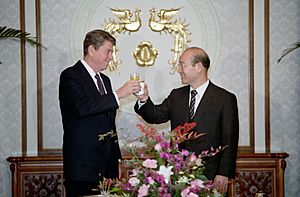
Chun was president during the Cold War. His foreign policies focused on fighting communism. This included dealing with North Korea and the Soviet Union.
The United States pressured South Korea to stop developing nuclear weapons. Japanese newspapers reported that Chun was the real leader of South Korea months before he officially became president.
In 1982, Chun announced a plan for reuniting Korea. However, North Korea rejected the plan many times. From 1986 to 1988, Chun also worked with President Corazon Aquino of the Philippines. They discussed strengthening friendship between their countries in areas like economy, society, and culture.
End of His Presidency (1987)
Choosing a Successor
From the start of his presidency, Chun tried to prepare Noh Shin-yeong to take over after him. Noh Shin-yeong was made Minister of Foreign Affairs in 1980. In 1982, he became the Director of the Security Planning Bureau. In 1985, he was named Prime Minister.
Many of Chun's supporters did not like this choice. They felt that a successor should have a strong military background, not just political experience. Chun was eventually convinced to change his mind. He stopped pushing for Noh Shin-yeong to be the next president.
June Democracy Movement
The 1981 constitution said the president could only serve one seven-year term. Chun could not change this rule to run for president again in 1987. He also did not want to make the government more open to democracy.
On 13 April 1987, Chun gave a speech. He said that the next president would be one of his military supporters. He also said the president would be chosen by an indirect election, like the one that elected him. This made many people who wanted democracy very angry. Protests began across the country.
Two months later, Chun announced that Roh Tae-woo would be his party's candidate for president. This seemed to mean Roh would easily become president. This announcement led to the June Democracy Movement. Many large protests for democracy happened across the country. To calm the situation, Roh promised a more democratic constitution. He also promised the first direct presidential elections in 16 years. On 10 July 1987, Chun stepped down as head of his political party.
1987 Presidential Election
In the 16 December 1987 presidential election, Roh Tae-woo won. This was the first free and fair national election in South Korea in two decades. The other candidates, Kim Young-sam and Kim Dae-jung, split the votes. Chun finished his term and handed over the presidency to Roh on 25 February 1988. This was the first time power was peacefully transferred in South Korea's history.
After His Presidency (1987–1997)
In February 1988, during Roh Tae-woo's presidency, Chun was made chairman of the National Statesman Committee. This gave him a lot of influence in South Korean politics. However, in the 1988 National Assembly elections, Chun's party lost its majority. This led to special hearings about the "Fifth Republic." The National Assembly investigated the Gwangju Democratization Movement. They wanted to find out who was responsible for the deaths that occurred.
On 11 November 1988, Chun apologized to the nation in a public speech. He promised to give his money and belongings back to the country. Chun then resigned from the National Statesman Committee and his political party.
Chun decided to live for several years at Baekdamsa, a Buddhist temple. He did this to make up for his past actions. On 30 December 1990, Chun left the temple and returned home.
Death and Funeral
Chun died at his home in Yeonhui-dong, Seoul, on 23 November 2021. He died from complications of blood cancer. Chun died less than one month after his successor, Roh Tae-woo.
Chun never apologized for his role in the Gwangju events and his past actions. Because of this, the South Korean government did not hold a state funeral for him. His funeral was handled by his family, with no government help.
His body was taken to Seoul's Severance Hospital to be cremated. By law, Chun could not be buried in a national cemetery because of his past criminal record. His wife, Lee Soon-ja, said that Chun had asked his family to keep his funeral simple. He also asked them not to build a tomb for him. He wanted his ashes spread in areas that overlooked North Korea.
Honours
 Malaysia: Honorary Recipient of the Order of the Crown of the Realm (1981)
Malaysia: Honorary Recipient of the Order of the Crown of the Realm (1981) Thailand: Knight of Order of the Rajamitrabhorn (1981)
Thailand: Knight of Order of the Rajamitrabhorn (1981)
Images for kids
See also
 In Spanish: Chun Doo-hwan para niños
In Spanish: Chun Doo-hwan para niños


